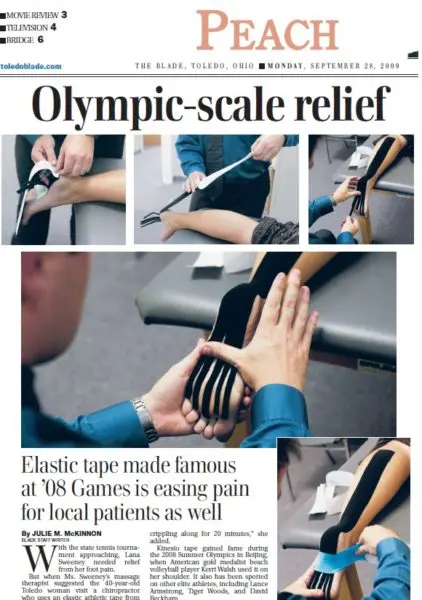Elastic tape made famous at ’08 Games is easing pain for local patients as well.
With the state tennis tournament approaching, Lana Sweeney needed relief from her foot pain. But when Ms. Sweeney’s massage therapist suggested the 40-year-old Toledo woman visit a chiropractor who uses an elastic athletic tape from Japan to treat patients, she doubted it would help. After all, Ms. Sweeney previously was told only surgery or cortisone shots would alleviate her pain from plantar fasciitis, an inflammatory condition.
Not only was Ms. Sweeney wrong about Kinesio Tex Tape’s benefits, she lost a bet with Dr. Bryan Royer, a Sylvania Township chiropractor who started using it about five years ago. Then again, although Ms. Sweeney owed Dr. Royer lunch after losing that bet, her USTA 4.0 team from Perrysburg Tennis Center took second place in the state competition last month. “I’ve become a believer, reluctantly, yeah, but a believer,” Ms. Sweeney said recently before Dr. Royer applied tape, which withstands bathing and stays intact a few days.
“It helps me get out of bed without crippling along for 20 minutes,” she added.
Kinesio tape gained fame during the 2008 Summer Olympics in Beijing, when American gold medalist beach volleyball player Kerri Walsh used it on her shoulder. It also has been spotted on other elite athletes, including Lance Armstrong, Tiger Woods, and David Beckham.

Still, professional and amateur athletes are not the only ones benefitting from Kinesio tape, said Dr. Royer and Wendy Harlett, a physical therapist from Heartland Rehabilitation in Perrysburg who also treats patients with it. After Joani Donovan of Holland “became a klutz” and fell a few months ago, hurting her knee, wrist, and neck, the massage therapist sought treatment from Dr. Royer.
Kinesio tape helped with pain and range of motion, Ms. Donovan said. “It gave me the strength to keep going when I was working,” said the 47-year old. “It’s just amazing.”
Pain in shoulders and lower backs also can be relieved by Kinesio tape, Dr. Royer said. Unlike traditional athletic tape, which is not as flexible, Kinesio tape when applied correctly assists and supports muscles without inhibiting a joint’s range of motion, he said. “It is really, really versatile in all the things it can do,” Dr. Royer said.
Developed more than 35 years ago by a chiropractor in Japan, Kinesio tape was introduced to the United States about a decade ago, said Mike McDuffie, marketing coordinator for Kinesio Holding Corp. in Albuquerque.
Physical and occupational therapist are the largest U.S. users of Kinesio tape, followed by chiropractors, Mr. McDuffie said. Athletic trainers only account for 15 percent to 20 percent of sales, although donating 50,000 rolls of tape for use during the Beijing Olympics is what got Kinesio noticed, he said. “Obviously, the Olympics got us a lot of coverage and really opened the door,” Mr. McDuffie said.
Dr. Royer, however, first learned how to use Kinesio tape while a chiropractic student at National University of Health Sciences in Illinois.
Kinesio tape relieves pain in muscles and corrects misalignment of joints, Dr. Royer said. It also increases circulation by lifting skin, which helps with bruising and lymphatic flow, he said.
“The sooner you can get the inflammation down, the sooner you can get the healing to begin,” Dr. Royer said.
Typically, Kinesio tape is used temporarily, Dr. Royer said. He uses it on roughly half of his patients, often with other treatment techniques, he said.
For Ms. Sweeney’s chronic foot condition, for example, Dr. Royer also uses a technique to break up scar tissue, restoring function and eliminating pain. Ms. Harlett, the physical therapist, said Heartland Rehabilitation in Perrysburg started using Kinesio tape on patients a few months ago.
Originally, using Kinesio was an extension of tape applied by doctors to treat patients with foot conditions, Ms. Harlett said. Now the Perrysburg therapists use Kinesio tape on shoulder strains and other problems, and 40 to 50 percent of patients are treated with it, she said.
The tape can be used to strengthen or inhibit muscles, depending on how it is positioned, Ms. Harlett said. Patients often need support on their injuries to gain relief, she said.
“I’ve had patients who say, ‘Gosh, if you keep your hands there all day, it would be great,’ ” she said.
Kinesio tape, which is like a second skin, provides that stability without being invasive, Ms. Harlett said.
“The more we started researching it and the more we got into it, the more uses we found for it,” Ms. Harlett said. She added: “We’ve found some very good success with it.”
Published in the Toledo Blade on September 28, 2009
